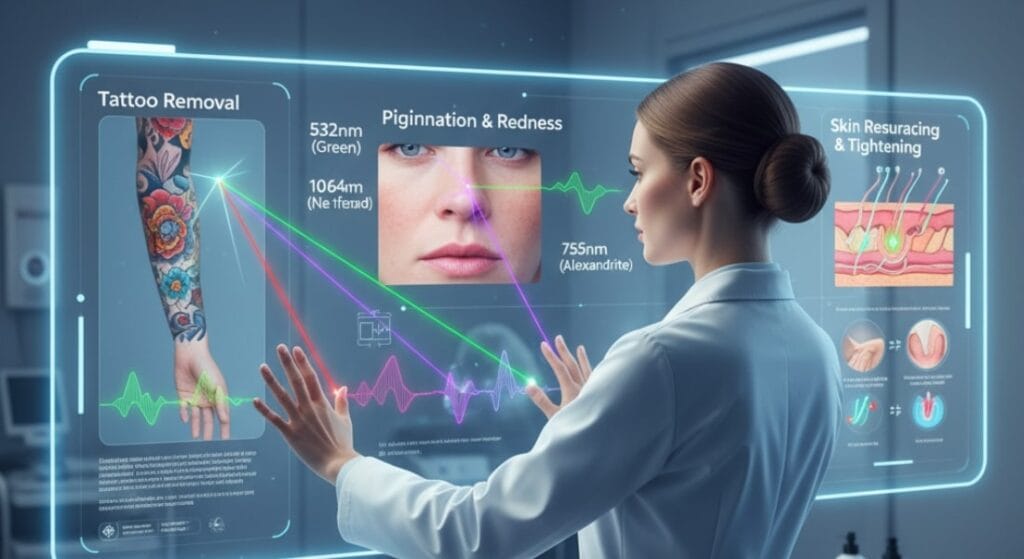Laser technology has become an indispensable tool in modern dermatology and aesthetic medicine, offering unparalleled precision and efficacy for a wide range of patient concerns. From hair removal to tattoo fading and vascular lesion treatment, lasers have revolutionized the way clinics approach complex conditions. However, the true power of this technology lies not in the device itself, but in the specific laser wavelength it emits. For dermatologists, cosmetic surgeons, and clinic owners, a deep understanding of different laser wavelengths and their uses is fundamental to delivering safe, effective, and predictable results.
This article serves as a comprehensive, technical guide for professionals, delving into the science behind laser wavelengths and their targeted interactions with the skin. We will explore the most common wavelengths used in aesthetic practice, their specific clinical applications, and the factors you must consider when selecting the right laser device for your practice. Furthermore, we will highlight how leading-edge systems, such as the multi-application Vera Touch and the advanced Platina Ice+ from Aakaar Medical Technologies Ltd, are designed to meet the diverse needs of modern clinics in the evolving Indian market.
Basics of Laser Wavelengths
A laser is a device that produces a beam of highly concentrated, monochromatic (single wavelength) light. The “wavelength,” measured in nanometers (nm), is the distance between two consecutive peaks of the laser’s electromagnetic wave. This single variable is the most critical factor in determining how the laser will interact with biological tissue.
The principle of laser medicine is based on selective photothermolysis, a concept that states that a specific target in the skin—a “chromophore”—can be heated and destroyed without damaging the surrounding tissue. The success of this process depends on three key factors:
- Matching the wavelength: The laser wavelength must be highly absorbed by the target chromophore.
- Sufficient energy: The laser must deliver enough energy to heat the target to a destructive temperature.
- Pulse duration: The laser pulse must be shorter than the thermal relaxation time of the target—the time it takes for the target to cool down—to confine the heat and prevent diffusion to the surrounding tissue.
The primary chromophores in the skin are melanin (found in hair and pigmented lesions), haemoglobin (found in blood vessels), and water. Each has a distinct absorption spectrum, which dictates which laser wavelength is best suited for a particular treatment.
- Melanin: Absorbs a broad range of light, particularly in the visible to near-infrared spectrum (approximately 400-1000 nm).
- Haemoglobin: Has strong absorption peaks in the visible green and yellow light spectrum (around 532 nm, 585 nm).
- Water: Absorbs most strongly in the infrared spectrum (above 1400 nm), making these wavelengths ideal for skin resurfacing.
By selecting the right wavelength, a clinician can precisely target a specific chromophore, maximizing treatment efficacy while minimizing damage to non-targeted tissue.
Common Laser Wavelengths in Aesthetics & Dermatology
The clinical applications of lasers are as varied as their wavelengths. A closer look at some of the most prominent wavelengths used in aesthetic practice reveals their unique strengths and ideal applications.
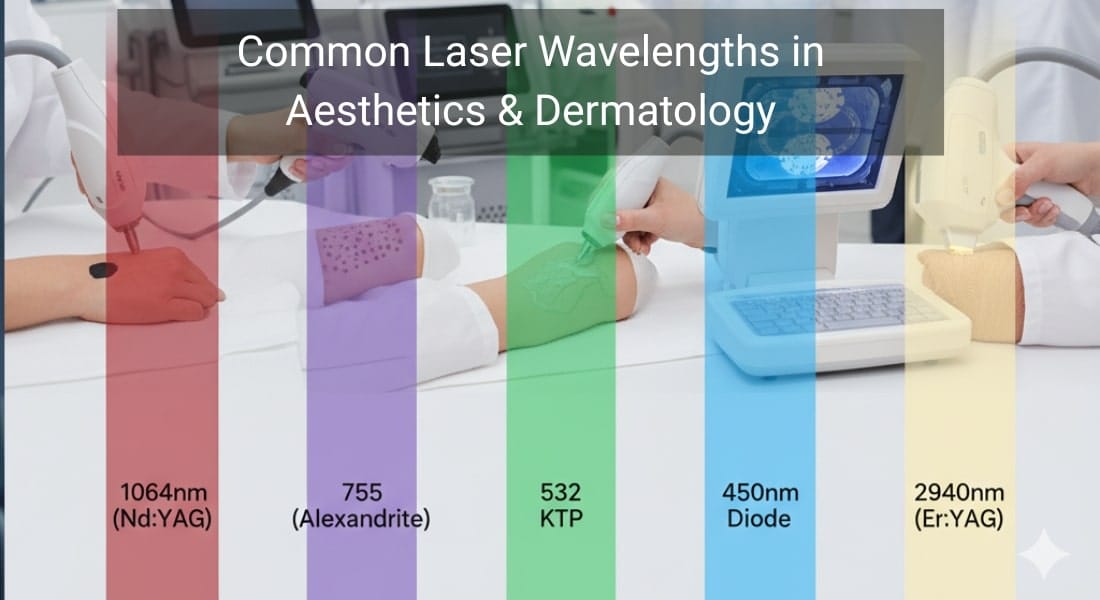
532 nm (KTP Laser)
The 532 nm wavelength, often referred to as a KTP (potassium titanyl phosphate) laser, is in the green portion of the visible light spectrum.
- Target Chromophores: Primarily haemoglobin and, to a lesser extent, melanin.
- Clinical Uses: It is highly effective for treating superficial vascular lesions such as telangiectasias (spider veins) on the face, broken capillaries, and some types of pigmented lesions like freckles and sunspots. The high absorption by haemoglobin allows it to coagulate small blood vessels with minimal effect on the surrounding skin.
- Risks & Limitations: Due to its strong absorption by melanin, the 532 nm laser carries a higher risk of post-inflammatory hyperpigmentation (PIH) and hypopigmentation in patients with darker skin tones (Fitzpatrick types IV-VI). It is therefore most safely used on lighter skin types (I-III).
755 nm (Alexandrite Laser)
The Alexandrite laser operates at a 755 nm wavelength, which falls within the near-infrared spectrum. It is renowned for its high affinity for melanin.
- Target Chromophore: Melanin.
- Clinical Uses: The 755 nm laser is considered the gold standard for hair removal on patients with fair to medium skin tones (Fitzpatrick types I-III). Its strong absorption by melanin in the hair follicle allows for efficient destruction of the follicle. It is also highly effective for treating pigmented lesions like solar lentigines and age spots.
- Risks & Limitations: The high absorption by melanin makes it less suitable and potentially risky for darker skin tones, where it can cause burns or dyspigmentation by targeting the melanin in the epidermis.
808–810 nm (Diode Laser)
The diode laser, typically operating in the 808 nm or 810 nm wavelength, is the most widely used laser for permanent hair reduction. It strikes an optimal balance between melanin absorption and deep tissue penetration.
- Target Chromophore: Melanin.
- Clinical Uses: This wavelength is the best laser technology for hair removal across a wide spectrum of skin types, including darker skin tones (up to Fitzpatrick type VI) when used with appropriate cooling and a lower fluence. Its deeper penetration compared to the Alexandrite laser allows it to target the hair follicle more effectively, even in deep-seated hair. The 810 nm diode laser applications are vast, making it a cornerstone of any aesthetic practice.
- Advanced Diode Technology: Aakaar Medical Technologies Ltd’s Platina Ice+ diode laser is an excellent example of a multi-wavelength diode system. Its trio-clustered diode technology combines 755 nm, 808 nm, and 1064 nm wavelengths in a single handpiece, offering superior versatility and efficacy. This allows for a blended approach that simultaneously targets the hair follicle at multiple depths, ensuring comprehensive coverage and optimal results for all skin types and hair colours. The device’s integrated cooling system also ensures patient comfort and safety, a critical consideration for any hair removal treatment.
1064 nm (Nd:YAG Laser)
The Nd:YAG laser operates at a longer wavelength of 1064 nm, which is in the near-infrared part of the spectrum. This wavelength has the deepest penetration of the common aesthetic lasers.
- Target Chromophores: Melanin, haemoglobin, and water.
- Clinical Uses: The 1064 nm Nd:YAG laser benefits are its ability to penetrate deep into the skin with low melanin absorption. This makes it a go-to laser for treating hair removal on darker skin types (IV-VI) with minimal risk of epidermal damage. It is also highly effective for treating deeper vascular lesions, such as leg veins, and for tattoo removal of black, blue, and green inks. Its ability to stimulate collagen production also makes it a valuable tool for non-ablative skin rejuvenation.
- Multi-wavelength Platforms: For clinics seeking ultimate versatility, multi-wavelength platforms that integrate multiple lasers are a smart investment. For example, the Vera Touch laser device is a powerful multi-application platform that combines different laser technologies, allowing clinics to treat a wide array of conditions from a single machine. Such devices eliminate the need for multiple single-purpose lasers, providing a cost-effective solution for practices looking to expand their treatment portfolio.
Factors Clinics Should Consider When Choosing a Laser Device
When investing in an aesthetic laser, the choice goes far beyond simply selecting a wavelength. Clinic owners and practitioners must consider a range of practical factors to ensure the device is a valuable addition to their practice.
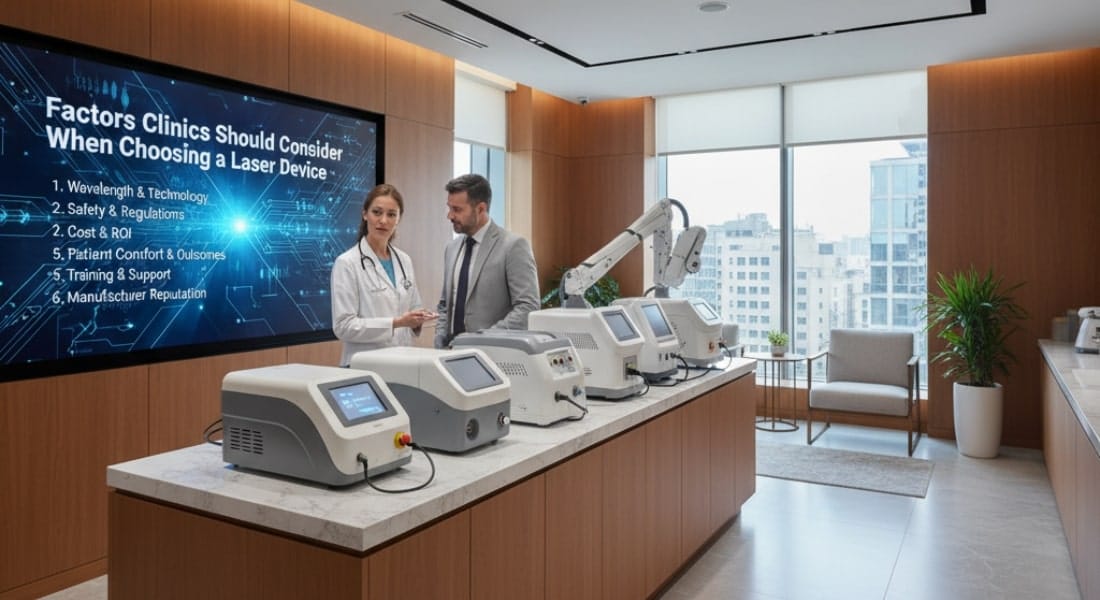
- Patient Demographics: The key to a successful practice is understanding your patient base. Are you primarily serving a population with darker skin tones? Then a device with a strong 1064 nm Nd:YAG or 810 nm diode laser is a must. If your patient base is predominantly fair-skinned, a 755 nm Alexandrite laser might be a priority.
- Treatment Portfolio: What services do you want to offer? If your focus is solely on hair removal, a specialized device like the Platina Ice+ is an excellent choice. If you aim to provide a comprehensive range of services, from skin rejuvenation and pigmentation to vascular lesions, a versatile, multi-wavelength platform like Vera Touch offers greater flexibility and a higher return on investment.
- ROI and Business Model: A laser device is a significant investment. Consider the upfront cost, maintenance requirements, and potential revenue streams from different treatments. Devices with multiple applications can open up new business opportunities and attract a broader clientele.
- Training and Support: The best laser device is only as good as the practitioner using it. Ensure the manufacturer provides comprehensive training, ongoing technical support, and clinical guidance to maximize the device’s potential and ensure patient safety.
Comparing Vera Touch and Platina Ice+ for Clinical Use
Aakaar Medical Technologies Ltd understands the diverse needs of modern dermatology clinics. We offer a portfolio of advanced B2B laser solutions in India designed to empower practitioners with reliable, effective, and profitable devices.
Platina Ice+: The Gold Standard for Hair Removal
The Platina Ice+ is an investment for clinics where hair removal is a primary revenue generator. Its trio-clustered diode laser technology (755 nm, 810 nm, and 1064 nm) ensures it is the best laser technology for hair removal for virtually every patient who walks through the door.
- Unmatched Efficacy: The synergy of the three wavelengths targets different depths of the hair follicle, resulting in faster, more effective, and longer-lasting hair reduction.
- Superior Safety and Comfort: The advanced USA-imported semiconductor cooling system provides continuous skin cooling, minimizing discomfort and reducing the risk of burns, making the treatment safe even for sensitive skin.
- Business Efficiency: With a high repetition rate and large spot size, Platina Ice+ significantly reduces treatment time, allowing clinics to serve more patients and increase their daily revenue.
Vera Touch: The Ultimate Multi-Application Platform
For clinics seeking a singular device to expand their service offerings, the Vera Touch is an ideal solution. This multi-application platform is engineered for versatility and precision.
- Comprehensive Versatility: Vera Touch can be configured with multiple handpieces and wavelengths (including Nd:YAG, Alexandrite, and Diode) to perform a wide range of procedures. From hair removal and pigmentation to vascular and tattoo removal, this single device can address a vast number of patient concerns.
- Clinical Precision: The system’s intuitive software and customizable settings allow practitioners to fine-tune treatment parameters for each patient, ensuring optimal results and the highest standard of care.
- Maximizing ROI: By consolidating multiple treatment modalities into one device, Vera Touch enables clinics to streamline operations, reduce capital expenditure on multiple machines, and maximize their return on investment.
Both Vera Touch and Platina Ice+ represent a reliable investment for dermatology clinics, offering a combination of cutting-edge technology, clinical efficacy, and business-focused design.
Future Trends in Laser Wavelength Technology
The field of aesthetic lasers is constantly evolving. Future advancements are likely to focus on even greater precision and customizability.
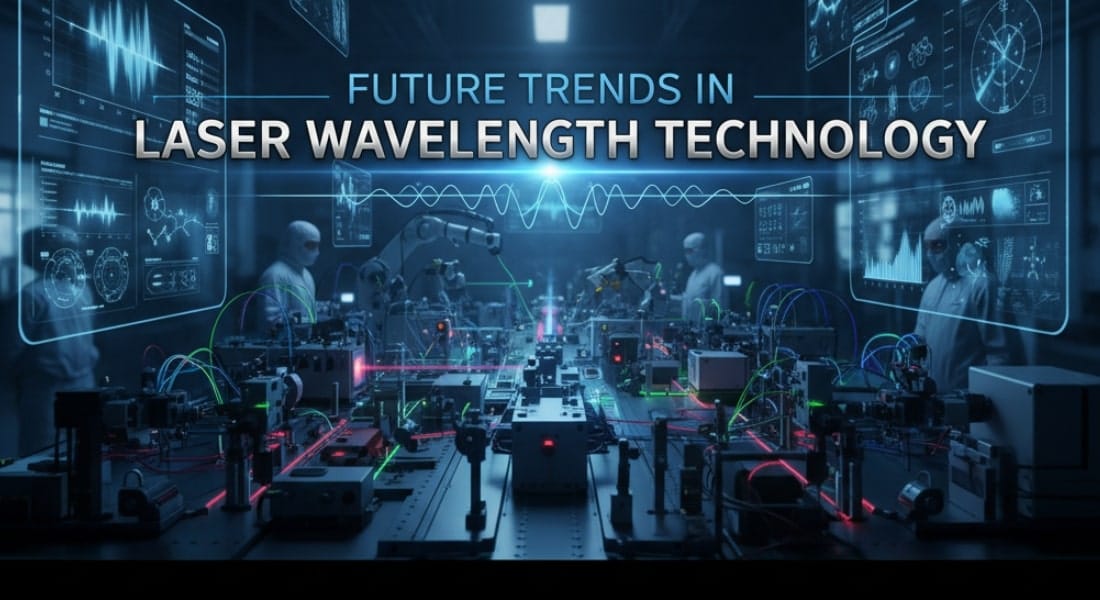
- Combination Lasers: The trend toward multi-wavelength platforms will continue, with devices combining different wavelengths and energy sources (e.g., laser with RF) to achieve synergistic effects for more complex conditions.
- AI-Assisted Systems: Artificial intelligence will play a bigger role in optimizing treatment parameters. AI-powered devices will analyze a patient’s skin type, hair characteristics, and treatment goals to automatically suggest the safest and most effective settings.
- Growing Market in India: With rising disposable income and a growing demand for cosmetic procedures, the market for aesthetic laser devices for dermatologists in India is set for rapid expansion. Clinics that invest in versatile and reliable technology will be best positioned to capitalize on this growth.
Frequently Asked Questions
Q1: What is the best wavelength for hair removal across all skin types?
A: There is no single “best” wavelength for all skin types. The ideal approach is to use a device that combines multiple wavelengths, such as the 755 nm, 810 nm, and 1064 nm found in multi-wavelength diode lasers. This allows for safe and effective treatment of all skin tones, from fair to dark.
Q2: How does an 810 nm diode laser differ from an Alexandrite laser?
A: The 810 nm diode laser has a slightly longer wavelength than the 755 nm Alexandrite laser. This allows it to penetrate deeper into the skin to target the hair follicle more effectively. While Alexandrite is a great choice for fair-skinned patients, the 810 nm diode laser is considered safer and more versatile for a wider range of skin types, particularly darker ones, due to its lower melanin absorption.
Q3: Can one laser wavelength treat all skin conditions?
A: No. Due to the principle of selective photothermolysis, a single wavelength cannot effectively target all the different chromophores found in the skin. For example, a wavelength good for treating vascular lesions may be ineffective for hair removal. This is why multi-wavelength and multi-application platforms are becoming so popular in clinics.
Q4: Why should clinics invest in multi-wavelength platforms?
A: Multi-wavelength platforms provide greater versatility and a higher return on investment. Instead of purchasing multiple single-purpose devices, a clinic can invest in one machine that can perform a variety of treatments, from hair and tattoo removal to vascular lesions and skin rejuvenation.
Q5: How do Platina Ice+ and Vera Touch benefit dermatology practices?
A: Platina Ice+ is an elite, dedicated hair removal system that offers unparalleled speed, comfort, and efficacy for all skin types. Vera Touch, on the other hand, is a versatile, multi-application platform that allows clinics to offer a broad range of advanced laser treatments from a single device, maximizing their clinical capabilities and business potential.
Conclusion
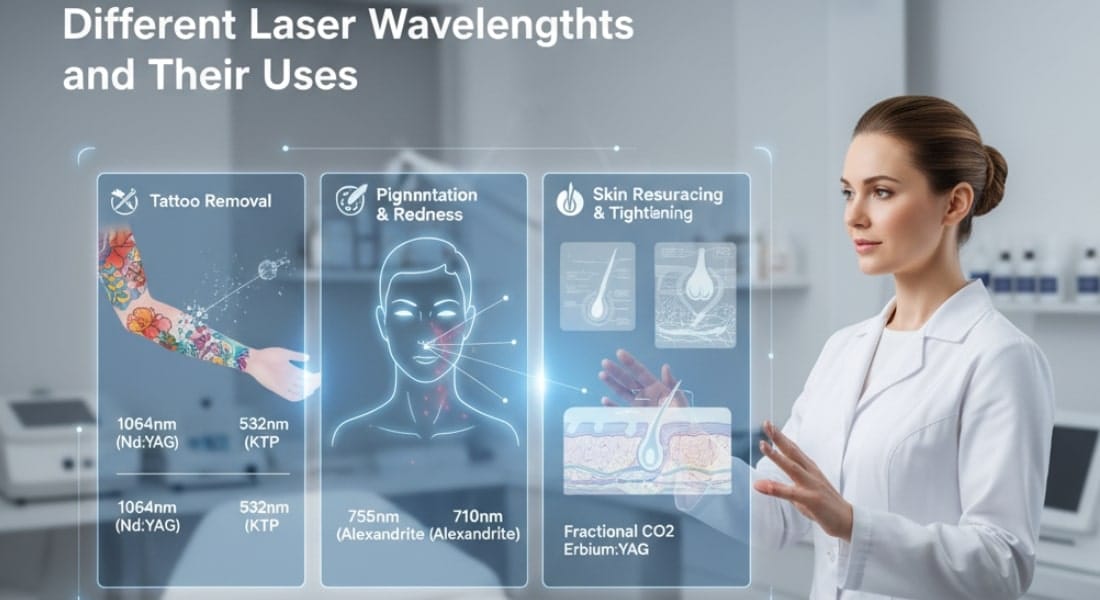
A deep understanding of different laser wavelengths and their uses is the cornerstone of a successful and safe aesthetic practice. The precision of laser technology, when correctly applied, can deliver life-changing results for patients. By choosing devices that are scientifically sound and business-focused, clinics can not only enhance their treatment portfolio but also ensure a high return on investment.
At Aakaar Medical Technologies Ltd, we are committed to empowering dermatologists and clinic owners with the very best aesthetic laser devices for dermatologists. From the gold-standard hair removal capabilities of Platina Ice+ to the comprehensive, multi-application power of Vera Touch, our devices are designed to meet the evolving demands of the modern aesthetic market.

